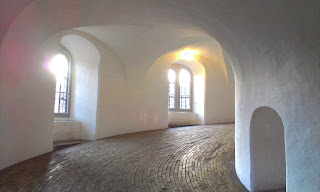The Frederiksberg Christmas market had some really lovely handmade items, like these baskets.
And some Christmas ornaments for the tree, in every color. I've seen a lot of black ornaments in shops along with fuscia, lime green, blues, and yellows.
There were some booths selling old ornaments and decorative items. We'll call them vintage.
Greenery was everywhere. Danes like their wreaths and garlands real, I haven't seen any fake trees or garlands anywhere. See those tiny trees in the pots behind the wreaths? They're everywhere, I have yet to see a tree larger than 2 feet anywhere. I bought a tiny tree for my window sill.
Next up was the market at Tivoli Gardens. The Danes are also pretty proud of Tivoli. It opened in 1843 and is the second oldest amusement park in the world. Its kind of like Disney land, but on a much smaller scale. An entrance ticket gets you in the door and lets you see any performers in the public spaces, play the games in the arcade areas, and gets you into the many restaurants inside. It does not, however, let you ride the rides. That's a separate ticket. Its beautifully decorated for the holidays.
And there are strolling performers.
And live reindeer in front of the Chinese pagoda. They're very multicultural.
This building was pretty impressive. I didn't have time to wander inside, so I can't say what's in there.
Tivoli's Christmas theme this year was Russia, so they imported Ded Moroz, or Grandpa Frost.
They also had a small version of St. Basil's Cathedral in Moscow.
I also explored a Christmas market at the Swedish church which had lots of herring-themed items and many booths selling more "vintage" items. They also had homemade candy and hand-knitted items.
The last market I explored was in Nyhavn, an area downtown with what must be the most photographed row of houses in Denmark.
The booths in Nyhavn were, unfortunately, not all the interesting. Some goodies to eat, some jackets and hats from Norway, some Christmas-themed trinkets from China, and this:
These are garlic graters. They also grate chocolate, parmesan, and a whole host of other foods which you would find out if you stopped to listen to their spiel. Mom and I run into the Garlic Grater Girl at several craft fairs. She always insists she hand-makes the ceramic dishes herself. I guess she's exporting them to Denmark now?
There are a few markets that don't open until December, so I am hopeful a few of them will be better than these. The one in Christiania should be interesting even if there's nothing to buy. Christiania is the "free" area of Copenhagen where they don't recognize the Danish government. Since the 1970s they have made their own laws and the government looks the other way. Pot is their biggest export. Like I said, their crafts should be...interesting.






























